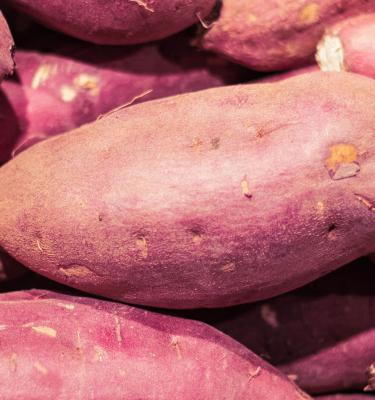

How to grow & care for sweet potatoes
Sweet potatoes rambling vines grow tubers beneath the ground. These vigorous and productive vines can be grown in a large pot or on the ground and their vines can be encouraged to grow up a trellis support.
Sweet potato tubers come in a range of colours including the common orange variety ‘Beauregard’, a red-skinned variety called ‘Northern Star’, the white-skinned, with purple flesh variety ‘Hawaiian Sunshine’ and the purple-skinned, white-fleshed variety ‘Murasaki’.
Sweet potatoes are frost sensitive, so they are best grown in warmer climates or during the frost-free months in cooler regions. The tubers will be ready to harvest 4-6 months after planting and the leaves can be cooked up as a spinach or silverbeet substitute.
Top 4 steps to growing sweet potatoes
- Choose a full sun position in your garden or grow in large pots.
- The vigorous vines can be trained up a trellis or teepee support
- Improve the soil before planting by adding compost and organic fertiliser
- While you wait for the tubers to develop, harvest some of the leaves and use them as you would silverbeet or spinach.
Shopping List
- Sweet potato “slips” or potted sweet potato plants
- Scotts Performance Naturals™ Organic Based Soil Improver
- Scotts Performance Naturals™ All Purpose Organic Based Fertiliser
- If growing in pots, Scotts Performance Naturals™ Premium Organic Based Potting Mix
- Garden trowel
- Trellis or support structure *optional
Prepare
Choose a full sun spot, protected from high winds to plant your sweet potatoes. Sweet potatoes are best grown in soil enriched with Scotts Performance Naturals™ Organic Based Soil Improver and Scotts Performance Naturals™ All Purpose Organic Based Fertiliser - dig these through the top 10-20cm of soil before planting. Make sure your soil is free draining and friable before planting.
In warm regions, sweet potatoes can be grown year-round, while in cold areas with frost it’s best to grow sweet potatoes in the frost-free seasons of spring and summer.
If you’d prefer to prevent the rambling sweet potato vine from spreading you can train it to grow up a trellis or support system. Install this before planting to avoid disturbing or harming the tubers as the plant grows.
Planting in the garden
Plant sweet potatoes about 1-1.5 metres apart if allowing their vines to trail along the ground. You can plant closer if you’re encouraging the plants to grow up a trellis system.
Lightly mulch the soil around plants after planting with organic sugar cane to retain moisture.
Growing from slips
Sweet potatoes can be grown from “slips” or shoots from whole tubers. Cut a store-bought organic sweet potato tuber in half and place each half (cut side down) in a shallow dish or saucer of water.
Leave this half-submerged tuber on a warm windowsill and keep the water topped up so that the cut half the tuber piece is always submerged in water.
In a few weeks, once the slip produces roots and green shoots it can be transplanted into a pot filled with Scotts Performance Naturals™ Premium Organic Based Potting Mix or planted straight into a prepared garden bed.
Planting in pots
Sweet Potatoes can be grown in large pots around 50cm by 50cm. Fill the pot with Scotts Performance Naturals™ Premium Organic Based Potting Mix and install a support trellis or teepee if you’d like to train the vines upwards, rather than letting them cascade over the sides of the pot.
In the centre of the pot plant 1 sweet potato slip or plant and water it in well.
Harvest
In warmer climates, sweet potatoes will be ready to harvest 16-18 weeks from planting. They’ll take longer to reach maturity in cooler climates.
The sweet potato tubers are ready to harvest once the leaves of the vine begin to yellow and die back. Use a fork to carefully lift the tubers, being careful not to damage them. Brush any loose soil from them and allow them to dry before storing them in a cool, dark and dry place indoors until you’re ready to eat them.
Impatient gardeners will be happy to know that you don’t have to wait for the tubers to begin harvesting from your sweet potato vine! The leaves are also edible and can be sautéed, stir-fried, used in salads or added to stews and casseroles - treat them as you would baby spinach leaves.
.jpg)
Pests & Diseases
Sweet potato weevil can cause serious damage to your harvest. To prevent these weevils infesting sweet potato crops, practice good crop rotation and don’t grow sweet potatoes in the same space 2 seasons in a row.



